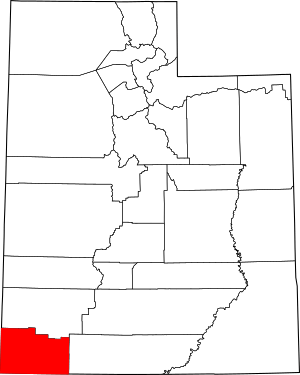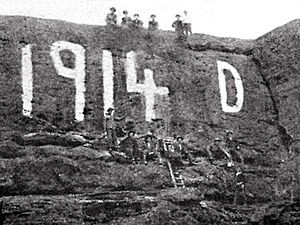Utah's Dixie facts for kids

Dixie is a special nickname for a warm, lower-elevation area in the southwest corner of Utah. It's mostly found in Washington County. This area is part of the northeastern Mojave Desert, located south of Black Ridge and west of the Hurricane Cliffs. Its winters are much milder and warmer than in other parts of Utah.
The Southern Paiute people lived here first. Later, after the Mexican–American War, the area became part of the United States. In 1854, members of the Church of Jesus Christ of Latter-day Saints moved to this region. They aimed to start a mission and began growing cotton and other crops around Santa Clara, Utah. By 1860, the Paiute population had decreased due to new diseases and settlers moving in.
Because of its warm climate, the importance of cotton farming, and the fact that some early settlers came from Southern states, the area was nicknamed "Dixie." This name refers to the "Dixie" region in the southern United States, which was known for its warm weather and cotton farms.
Contents
Why Was it Called the Cotton Mission?
The area was first known as the "Cotton Mission." This name came from a message by Brigham Young in 1856. He wanted the people in the Great Basin to be able to produce everything they needed themselves. He encouraged everyone to grow cotton and flax. He also asked people with money to bring in machines to make cotton and woolen goods.
Who Were the First Settlers?
The first groups of settlers arrived in the spring of 1857. Many of them came from Southern states like Mississippi, Alabama, Virginia, Texas, and Tennessee. These settlers brought their knowledge of farming, which was very helpful for growing crops in the new area.
What Were the Early Problems?
Life was very hard for the early settlers. The environment was tough, with very hot summers. People had to work constantly, and many got sick with malaria. Some settlers even left after the first season because it was so difficult.
In 1858, out of about 400 acres planted with cotton, only 130 acres were successful. Growing cotton and food crops depended on irrigation, which meant everyone had to work together to build and maintain water systems. There were often food shortages. Sometimes, people had to eat wild plants like pigweed and alfalfa just to survive. Despite these challenges, the community shared their religion, worked together, and even shared their economy for a while.
When Did the Cotton Mission End?
The Cotton Mission did not work out as well as Brigham Young had hoped. The cotton fields didn't produce as much as expected, and growing cotton never became a major way for people to earn money. Even though a cotton mill was built in the town of Washington and used for a few years, it stopped working regularly by 1897.
How Did "Dixie" Become the Name?
Local people and others in Utah started using "Dixie" to describe this area. In 1915, the local school, St. George Stake Academy, officially changed its name to Dixie State College. Soon after, the word "Dixie" was painted on Sugarloaf, a red rock hill above St. George. This hill, known as "Dixie Rock," had previously been painted with the graduating class year and a "D."
The use of the name "Dixie" became more common during a time when people were looking back at the American Civil War in a new way. This included the idea of the Lost Cause of the Confederacy, which was a way of remembering the South that made it seem more heroic. Many artists and people from the North became interested in Southern stories and the idea of a simple, farming life. This helped make the name "Dixie" popular.
Many local businesses and organizations in the area also started using the name "Dixie."
What Were the Links to the Confederacy?
Connections between Utah's Dixie and the Confederacy appeared again in 1952. That year, Dixie Junior College sports teams started calling themselves the "Rebels." By 1956, their mascot became a Confederate soldier. By 1960, the Confederate flag was even used as a school symbol. These changes happened around the same time as the University of Nevada Las Vegas (UNLV) also adopted the "Rebel" name and a mascot that looked like a wolf in a Confederate uniform. These changes also took place during the start of the civil rights movement in the United States.
Some old photos from the late 1960s show a parade float where a white student dressed formally held what looked like reins or a whip, while a man with his skin painted black pushed a plow.
People from the Southern Utah Anti-Discrimination Coalition have pointed out many activities at Dixie State College that were related to the Confederacy. These included "black-face minstrel shows" (until 2012), "mock slave auctions" (until the early 1990s), and the use of Confederate flags. The "Rebel" mascot was used until 2008, and "True Rebel Night" events continued. The school yearbook was even called The Dixie Confederate into the 1990s.
The Salt Lake Tribune newspaper looked at photos in these yearbooks. They reported that as late as the early 1990s, white students would sing in black face, dress as Confederate soldiers, act out slave auctions, and display the Confederate battle flag. Local newspapers also published stories and photos about these Confederate-related activities.
In 1987 and 1988, the community held a festival called a "Secession." Events included a large Southern-style ball with people dressed as Rhett Butler and Scarlett O'Hara, famous characters from a story about the South. A huge 40-foot Confederate flag was hung over St. George Boulevard. City, county, and school officials also displayed smaller Confederate flags in promotional photos. The local newspaper, The Washington County News, even had the Confederate flag on its masthead and said it was published in "St. George, Confederate State of Dixie."
Dixie Today
St. George is the largest community in the area. It was founded in 1861 when Brigham Young asked 300 families to move there and grow crops like cotton and grapes. Other communities in Washington County include Ivins, Santa Clara, Hurricane, LaVerkin, and Toquerville. The total population in this metropolitan area is nearly 180,000 people.
Today, "Dixie" is mostly used to refer to Washington County. However, sometimes it can mean a larger area, including nearby Kane and Iron counties, or even all of southern Utah. The phrase Payson-Dixon Line is sometimes used to suggest that everything south of Payson and the Wasatch Front is generally considered "Dixie."



